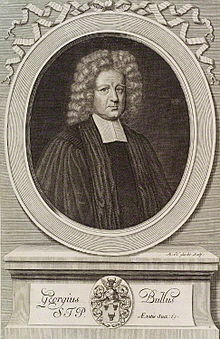George Bull
| George Bull | |
|---|---|
 |
|
| Born | 25 March 1634 Wells, Somerset |
| Died | 17 February 1710 (aged 75) Brecknock, Powys |
| Nationality | English |
| Occupation | theologian, bishop |
George Bull (25 March 1634 – 17 February 1710) was an English theologian and Bishop of St David's.
He was born, 25 March 1634, in the parish of St. Cuthbert, Wells, and educated in the grammar school at Wells, and then at Blundell's School in Tiverton under Samuel Butler. Before he was fourteen years old he went into residence at Exeter College, Oxford, where he became a friend of Thomas Clifford. In 1649, his tutor Baldwin Ackland refused to take the engagement, and together they left the university and settled at North Cadbury in Somerset.
He then studied under William Thomas, rector of Ubley and a puritan divine; Bull, however, was more influenced by his son Samuel Thomas, who directed Bull to read Richard Hooker, Henry Hammond, and Jeremy Taylor. On leaving Thomas, Bull applied to Robert Skinner, the ejected bishop of Oxford, for episcopal ordination, and was ordained by him deacon and priest the same day, aged 21. After his ordination he took the small living of St. George's, near Bristol. Bull, like Robert Sanderson and others, used the church prayers, which he knew by heart, without the book. He used to spend two months every year at Oxford and on his way there and back he visited Sir William Master of Abbey House, Cirencester. He met in this way the rector Alexander Gregory, whose daughter Bridget he married on Ascension Day, 1658. In the same year he was presented to the rectory of Siddington St. Mary's, near Cirencester, through the influence of Lady Pool, the lady of the manor. In 1659 the rectory at Siddington became one of the many places of meeting at which the friends of the exiled dynasty assembled to concert measures for the restoration of Charles II of England.
...
Wikipedia
